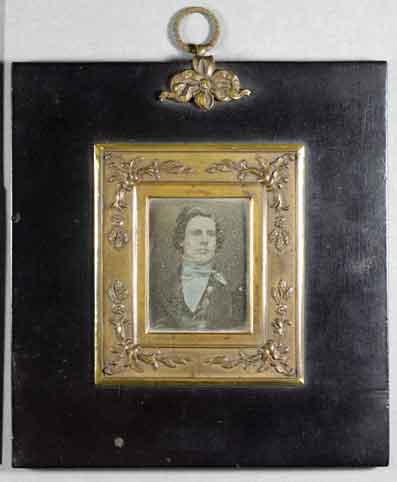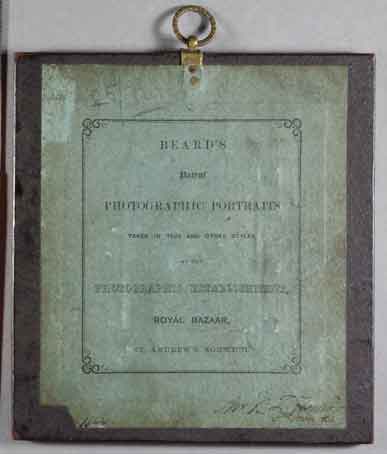1840 - 1860
Itinerant Daguerreotypist
Active in Norwich 1843-1844
Louis Daguerre and Isadore Niépce (the son of Daguerre’s late partner Joseph Niépce) announced the discovery of the Daguerreotype process in 1839. The very delicate photographic image was captured in a silver-mercury amalgam on a polished copper plate. Printed illustrations give no impression of the impact made by the first viewing of a Daguerreotype. Perception of the amazing high resolution is followed by the surprise that the image changes repeatedly from positive to negative when moved slowly around its vertical axis.
Viewers of the ‘magic mirror’ images were utterly astonished and although Daguerre sold the process to the French government for unrestricted use in France, he shrewdly patented its use in some foreign territories, England included. In 1841 Richard Beard, a successful London coal merchant and speculator in patents, bought the rights to the patent in England, Wales and the Colonies. One of Beard’s licensees was T. H. Ely1 about whom little seems to be known. However, advertisements appeared in the Norwich local press2 for a Daguerreotype studio opening on 8th December 1843. Ely, an itinerant photographer, operated at the Bazaar in St. Andrew’s Street until August 1844 having advertised that he would be opening in [King’s] Lynn and Wisbech. As yet just one image by Ely has been identified by Nick Burnett at the National Media Museum.’ The date in ink on the verso is March 1844.


On 2nd December 1843, Ely announced the forthcoming opening of his studio at the Bazaar in the local press.
BEARD’S
Patent Life-like Likenesses,
Taken by the Action of Light in a few seconds.
An Establishment is about to be opened on
FRIDAY next (December 8th), in the upper
part of the NORWICH BAZAAR, known as the
MUSEUM, for the purpose of taking PORTRAITS
by this wonderful process; which has been so ex-
tensively patronised in London and in other parts of
the kingdom. The Likenesses cannot fail to be
correct, and the new process of colouring adds
greatly to the beauty of the picture. They are ele-
gantly got up, so as to make either a handsome
present or an ornament for the boudoir.
Specimens will be shewn of the premises.
Inspection courted.
BEARD’S
PATENT
PHOTOGRAPHIC PORTRAITS
Taken daily from dawn to dusk.BAZAAR, NORWICH,
N. B. – These beautiful Likenesses are surpris-
ngly correct, and from the severe chemical test
they have undergone, are proved to last to infinity.
Prices – One and Two Guineas.
One wonders how many prospective sitters believed that their Likeness would last to infinity.
HER MAJESTY’S ROYAL LETTERS PATENT
BEARD’S
PHOTOGRAPHIC PORTRAITS,
WITH ALL THE RECENT IMPROVEMENTS
These truly Astonishing Likenesses continue to be Taken Daily from TEN to DUSK
AT THEROYAL BAZAAR, ST.ANDREW’S, NORWICH.
The Proprietor begs to return his most sincere thanks to the numerous Friends who have honoured him with their visits; and also to inform the Public generally, he is about open Establishments in the Towns of LYNN and WISBEACH, in the month of February, prior to which he hopes to see many more of the smiling faces of the Inhabitants of the City of Norwich.
The Proprietor pledges himself to send out none but Faithful and Pleasing Likenesses.
N.B. – Rooms are wanted in the Towns of Lynn and Wisbeach, for the purpose of taking these Por traits. It is necessary there should be a Sky and Side Light. A Green-house would be suitable.
Address Photographic Rooms, Bazaar, Norwich.
Sources and Notes
-
Linkman, Audrey. The Victorians. Photographic Portraits. London & New York: Tauris Parke Books, 1993. p139.
Norwich Chronicle and Norwich Mercury, weekly from 2 Dec 1843 to 17 February 1844.
See also:
Heathcote, Bernard & Pauline. A Faithful Likeness - The First Photographic Portrait Studios in the British Isles, 1841 to 1855. Published by the authors: Lowdham, 2002.Adamson, K.P. More Early Studios (2). The Photographic Journal, July 1988.
Robert Pols in his website <www.earlyphotographers.org.uk> provides this additional information on other studios opened by Ely in Norfolk.